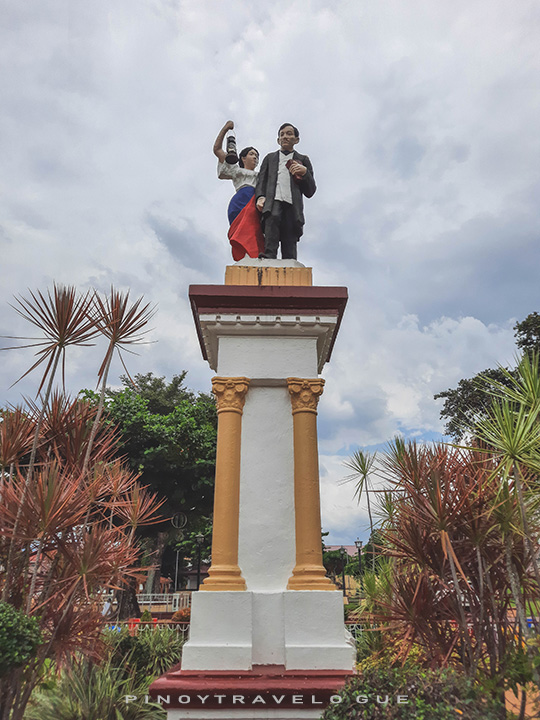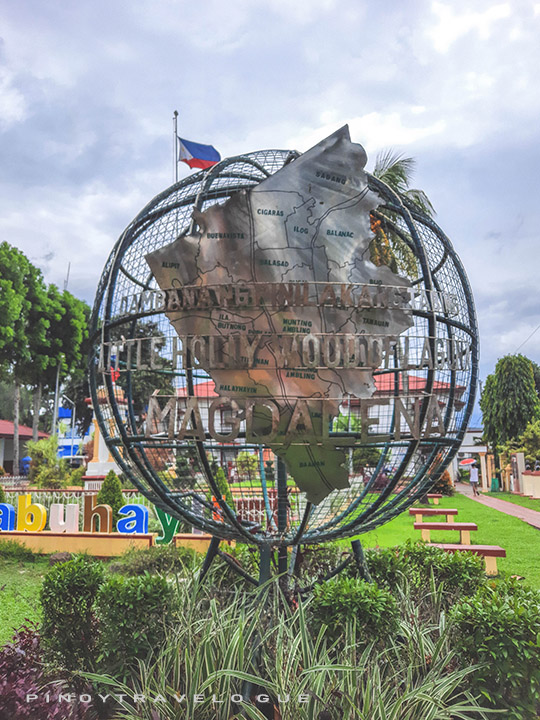You may have seen Magdalena at least once. If you watched the biopic Heneral Luna, ABS-CBN's drama series The Killer Bride, or the recently released satirical period comedy Ang Fraile, then you certainly did. These shows and a slew of films from the past decades were shot in this unassuming town in Laguna.
I had plans of traveling to Magdalena years ago for its exhilarating river rafting adventure—plans that were shelved for reasons that somehow escaped me now. Only when I visited Liliw did I finally set foot.
I was in awe of the town center's rustic setting. The extant Spanish Period edifices, age-old trees and contemporary park amenities coalesced upon the manicured expanse of the fenced plaza complex revealed to me that Magdalena was not just for thrill-seeking tourists. The poblacion's laid-back aura offers a place to chill out—good enough for a side-trip when visiting other towns in Laguna—or for the adventurous, a breathing space after the heart-stopping water activity.
Moreover, the sleepy town is witness to the life of a noteworthy figure in Philippine history and to the countless behind-the-scenes of the Philippine silver screen.
Magdalena Church and Municipal Hall
The town's church and municipal hall are vestiges of the country's colonial past. Their old-fashioned beauty is the main ingredient for Magdalena's countryside charm. Once a barrio of Majayjay, Magdalena became independent in 1820. By then, the presidencia (municipal hall), a makeshift school and the church, all made of light materials, were erected—basic requirements for a place to become a town.
Like the present edifice, the first municipal building was already bi-level. The bottom floor served as the town jail while municipal offices occupied the top. In 1871, the stone building that stands today began to be constructed and was completed in 1916, when Philippines was already under American rule.
Far across the town hall was the church, formerly made of wood and cogon. The present church chiefly made of adobe and sandstone was constructed in 1829 until the attached four-level, square-based octagonal bell tower was finished in 1861. The Baroque-style church stands on an elevated ground—the main portal is accessible via a stone stairway of about 20 steps. This elevation augments the massive church's imposing appearance. Mown grass covers the churchyard that adjoins the town square—the complex is a well-maintained lawn that kids and kids-at-heart would love to frolic on.
Inside the church was a rather intriguing story. During the insurgency, Emilio Jacinto, the high-ranking revolutionary whom Filipinos were taught as the "Brains of the Katipunan", fought the battle at the nearby Maimpis River. When the Spaniards captured him, he was mercilessly tossed inside the church convent. Smudges on the floor at one corner of the convent, near a staircase, were blood that dripped from the injured Emilio. Magdaleños believe that these traces have not disappeared after more than a century. Hence, they built a shrine in his honor. They enclosed the bloodstained corner with intricate wrought iron railings, Jacinto's straw hat and bolo were laid at the foot of an obelisk erected within the enclosure.
The Town Plaza
In Philippine towns established during the Spanish occupation, it’s common to see the church built opposite the town hall and both buildings adjoin the plaza mayor (main square). Leyes de Las Indias (The Law of the Indies), a set of laws that governed the Spanish colonies outside Europe, prescribed this spatial arrangement. In Magdalena, between the church and municipio is the town’s expansive plaza, a playground to locals and a spot that allures sightseers.
One family arrived and occupied the concrete picnic table under a tree—the mother was putting out their baon from a clear plastic box while her husband puffed away his cigarette. The grandmother sat and watched as the kids began running everywhere. On another table was a teenager preoccupied with her phone, perhaps waiting for friends or the park was her and her beau's rendezvous.
Several youngsters relished the soft grassplot—cartwheeled, roughhoused, ran around barefooted. They seemed to be the park habitués. Others were town visitors—with cameras around their necks, they walked toward the church and photographed the façade before coming in. The public park was conducive to unwinding with family, friends or one's Romeo or Juliet.
The Park was not an empty green space. There were concrete benches, a commodious gazebo, monuments, and red-painted footpaths and platforms. There's the multicolored I Love Magdalena signage that stands out from the park's dominant green hue. These "I Love..." markers are tourist magnets. In Magdalena, having the stately 17th century municipal building on background makes the marker more inviting for a snap.
Facing the town hall, just behind the I Love Magdalena, was Jose Rizal's statue. Unlike the usual Rizal monuments, the man in overcoat was not alone at the podium. He was with Inang Bayan. The maternal figure representing the nation holds a lantern as if she is guiding Rizal's path. Next to Rizal's was Emilio Jacinto's statue, holding a quill and wearing a pensive look. Though Manila-born, Magdaleños consider him a local hero.
Near the center of the plaza complex stands a memorial pillar for the World War II veterans. Similar monoliths exist in the plazas of other towns in Laguna such as in Sta. Maria and Pagsanjan.
Little Hollywood of Laguna
At the fringes of the square was Magdalena's own "Walk of Fame". It is a cobbled lane about 10 meters long, similar in purpose to that of Eastwood City and Hollywood—embedded along the pathway were floor tiles engraved with a star shape and names of movie celebrities. In Magdalena, there were only 10 stars. Actors and actresses who filmed their movie scenes in the town itself.
It as seems though that park administrators ceased in adding more stars to it. Currently honored there were artists whose careers had peaked in the 60s through the 90s only—the likes of Fernando Poe Jr., Vilma Santos and Sharon Cuneta—albeit the town is a go-to filming location even now. Weathering of the tiles was also evident. The star's gold color has faded and the embossed names were almost unreadable.
At the end of the "star-studded" strip was a globe-like structure, similar to but substantially smaller than the one in Mall of Asia. It bears Magdalena’s political map, superimposed on it are the phrases Dambana ng Pinilakang Tabing and Little Hollywood of Laguna.
Magdalena found its place in the movie industry through its laid-back atmosphere. It beckons filmmakers when they need a rural setting, such as in The Killer Bride where the plaza stood in for the fictional town of Las Espadas, or a scene depicting Spanish colonial era like in Heneral Luna where they used the church in lieu of Cabanatuan Church, the site where the testy protagonist met his demise. Same goes with Ang Fraile whose titular character is a Spanish friar.
Magdalena is a fourth class municipality, classified in terms of income generation, hence its small town vibe. Though continually progressing and adapting modernity, the town seemed to preserve its colonial beauty—its asset. This way, Magdalena remains a favorite filming location.
Magdalena is a laid-back town, its quaintness is its singular charm.
This story originally appeared in the November 2021 issue of Enrich Magazine.














